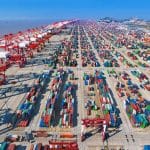RAILROAD STRIKES ARE RARE BUT CRIPPLING TO PORTS AND FREIGHT
The prospect of a potentially devastating rail workers strike is looming again. Fears of a strike in September 2022 prompted the Biden administration to pull out all the stops to get a deal between railroads and the largest unions representing their employees. That deal hinged on ratification by a majority of members at all 12 of those unions. So far, eight have voted in favour, but four have rejected the terms. If even one continues to reject the deal after further negotiations, it could mean a full-scale freight strike will start as soon as midnight on Dec. 5, 2022. Any work stoppage by conductors and engineers would surely interfere with the delivery of gifts and other items Americans will want to receive in time for the holiday season, along with coal, lumber, and other key commodities. Strikes that obstruct transportation rarely occur in the United States, and the last one involving rail workers happened three decades ago. But when these workers do walk off the job, it can thrash the economy, inconveniencing millions of people and creating a large-scale crisis.

SOUTHERN CALIFORNIA CONTAINERSHIP BACKUP CLEARED
Shipping officials in California have proclaimed the end of the container backup at the ports of Los Angeles and Long Beach after 25 months. The backup was one of the most visible signs of supply chain chaos driven by the pandemic fueled import boom. Since then, the backup has been reduced fairly steadily as imports have slowed and people have shifted back to services, reaching single digits in the last month. But as the Southern California backup ends, we’re seeing backups build in places like Houston, Savannah and New York as East and Gulf Coast ports are picking up a greater share of U.S. imports, prompted by importers shifting cargo to avoid potential problems associated with unresolved labor negotiations at West Coast ports. Now with a potential rail strike looming, it will be interesting to see if Southern California’s backup is set for a return or gone for good. Another issue… long wait times at the Panama Canal.
FMC GIVES GREEN LIGHT TO SOUTHEAST US CHASSIS POOL
The South Atlantic Chassis Pool 3.0 has received federal approval and should launch officially in 2023, but it will face a daunting challenge satisfying rising demand as discretionary cargo shifts from the West Coast to East Coast ports.
INEFFICIENT US TERMINAL FLOW AT CORE OF COVID-RELATED CHAOS
If there’s one lesson from the pandemic, it’s that working to ensure efficient container flow through US ports during sustained cargo surges must be the highest priority, whether it’s achievable or not.
PORT OF HOUSTON BOX VOLUME GROWS 18% IN FIRST 10 MONTHS 2022
Container volumes grew 18% year-to-date at Port Houston’s terminals, passing the 3m mark at 3.33m teu and in October box volumes returned to double-digit growth, continuing the trend seen throughout 2022. One change that was announced last month is the addition of new dwell rates. A sustained import dwell rate is expected to be implemented early next year to address long-term container dwell levels. The additional dwell rates are intended to minimize container storage at the terminal. Boxes must move quickly through the terminal to maintain a fluid environment and a superior level of service for our customers
CONTAINER DWELL FEE PUT ON HOLD THROUGH DEC. 16
The San Pedro Bay ports of Los Angeles and Long Beach will postpone consideration of the “Container Dwell Fee” for four weeks, until Dec. 16. Since the program was announced on Oct. 25, 2021, the two ports have seen a combined decline of 87% in aging cargo on the docks. Under the temporary policy, ocean carriers can be charged for each import container dwelling nine days or more at the terminal. Currently, no date has been set to start the count with respect to container dwell time. The ports plan to charge ocean carriers $100 per container, increasing in $100 increments per container per day until the container leaves the terminal. Any fees collected from dwelling cargo will be reinvested for programs designed to enhance efficiency, accelerate cargo velocity and address congestion impacts.




